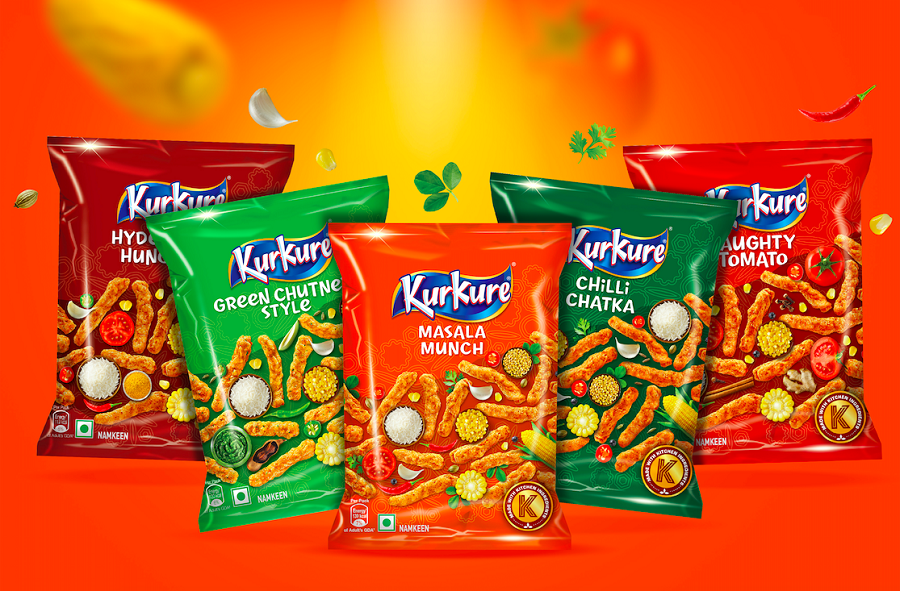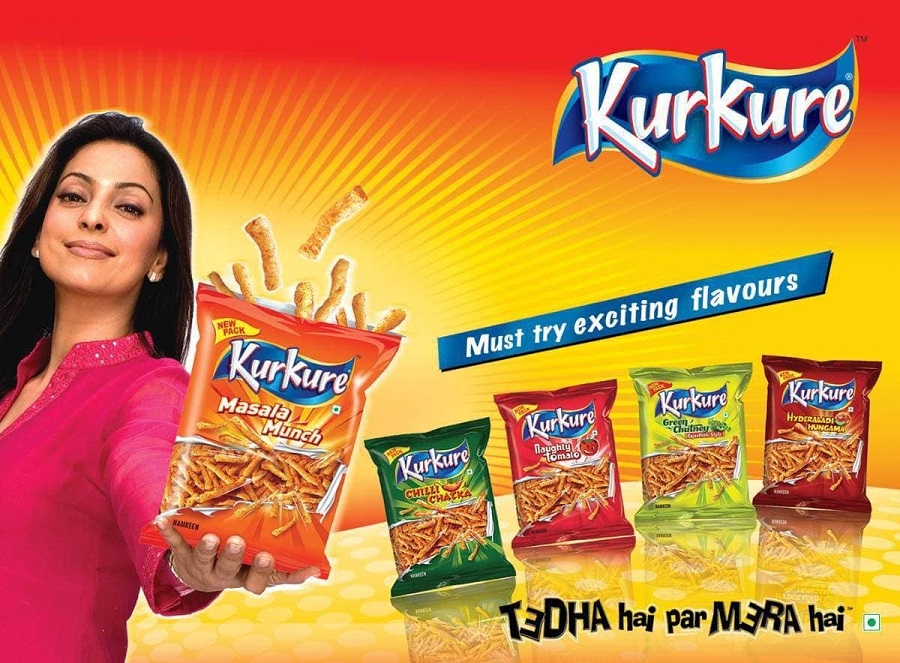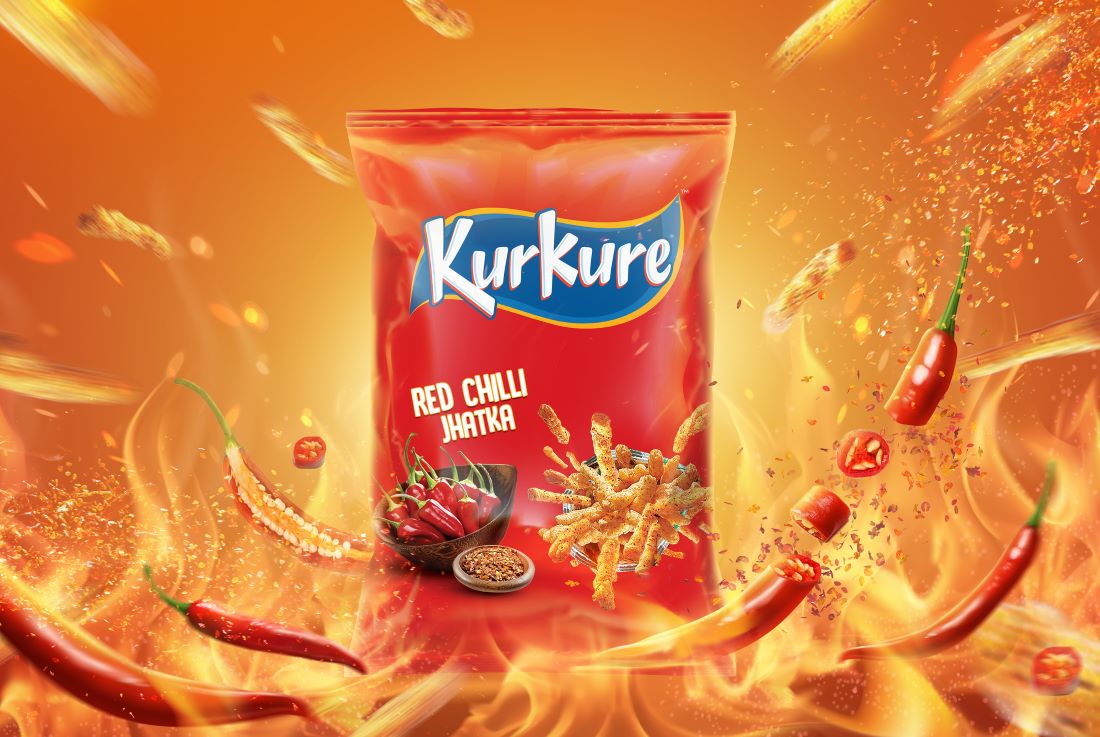Consumers across India have embraced Kurkure as a great tasting ‘namkeen’ snack, which was developed in the country. PepsiCo India’s portfolio includes eight brands, each of which generates more than INR 1000 crore in annual retail sales. Kurkure is one of these brands. PepsiCo’s expansion of the Kurkure trademark across various salty snacking formats is a reiteration of the company’s efforts to build strong master brands in India. The United Arab Emirates, Canada, Pakistan, and Bangladesh are just a few of the places where Kurkure is made and sold.
In Hindi, the word “kurkure” means “crispy.” An assortment of spices (turmeric), condiments (salt and sugar), tartaric and milk solids are used to make kurkure. Also, there is a flavour to it (natural and nature identical flavouring substances).
Table of Contents
Launch of Kurkure
Three years later, in 1999, Pepsico launched Kurkure as a sub-brand of its Lehar savoury snack line. Puffed corn snacks in a bright orange package were designed to make ‘namkeen’ more modern for Indians.
It was positioned as “Familiar taste in an innovative format” in its early years. As a consumer once put it, a “item number in the mouth,” it was launched with the tagline: “Kya karen, control nahin hota” to drive home the addictive taste of the product, which started the Kurkure advertising journey.
Kurkure became a social commentator on the changing Indian family because of its roots in the family social context. Snacks and laughter were supposed to keep families together.
Kurkure flavours


A marketing mix product strategy for the brand’s original product resulted in the creation of a wide range of Indian-inspired variations. Kurkure is available in a wide variety of flavours, including the original Masala Munch, which is a spicy corn meal snack, Green Chutney, which has a tangy mint flavour, Chilli Chatka, which is for spice lovers, Tamatar Hyderabadi Style, which is based on Hyderabadi regional tastes, Malabar Masala Style, which is inspired by Kerala dishes, and Masala Twists, which have a tangy flavour. The brand has also paid particular attention to the regional flavours of various Indian states, such as Punjab, Gujarat, and so on. Kurkure has come up with a variety of new products in order to combat regional competition. In order to bring the Indian flavour to the snacks, they use Indian gramme meals and spices, which are extremely popular and beloved by Indians.
Kurkure marketing
Pooja Ghai Rawal, an Indian television actress, was the first brand ambassador for Kurkure when it was first launched in India in 1999. As recently as 2004, Indian Hindi film actress Juhi Chawla appeared in commercials for Kurkure. Actress Simran was the face of Kurkure in Tamil Media when it was launched in 2008. As of 2012, the likes of Parineeti Chopra, Kunal Kapoor and Boman Irani were promoting Kurkure. Samantha Ruth Prabhu appeared in two Kurkure commercials in Tamil and Telugu in 2019.
Ayesha Omer, Hania Amir, and Iqra Aziz have all starred in television commercials for PepsiCo Pakistan, the PepsiCo subsidiary in Pakistan, since 2007.
Memorable Tedha Hai Par Mera Hai campaign
PepsiCo India launched a new 360-degree campaign for Kurkure in 2008, repositioning the “Masti” co-efficient to a “tedha” one as part of the Kurkure advertising journey in 2008.
Since then, they’ve rebranded themselves as the “Rangeela Indian snack that celebrates everyday imperfections.” ‘ It was then that the insight was derived from confident Indians who no longer aspire to be perfect but are comfortable with their imperfections and quirks.


To bring the much-needed edginess to this situation, Kurkure’s evergreen stance of “Tedha Hai Mera Hai” was born. Kurkure regained its lustre thanks to a series of commercials featuring actress Juhi Chwla’s tagline. So powerful was the tagline’s recollection that we began referring to our quirky loved ones as “Tedha hai par mera hai” in our daily lives.
Aside from Juhi’s bubbly personality, her incredible comic timing, and the fact that she was a mother and a housewife, Kurkure wanted to do something special with her. Kurkure decided to make a spoof of Kyunki Saas Bhi Kabhi Bahu Thi, a popular soap opera at the time, because housewives were often fans of television shows. From Bollywood classics to soap operas that helped tell the product stories of “Kahaani mein twist,” it went on and on.
As time passed, the words “Juhi” and “kurkure” became interchangeable. Evening teatime snacks like kurkure were later offered as an option. Juhi Chawla’s “Teda hai par mera ha” tagline has been the most popular of all kurkure taglines, followed by Parineeti Chopra, Kunal Kapur, Boman Irani, and Farida Jalal. During the Diwali season, the company released special gift packs as part of a marketing campaign.
Kurkure pricing
It comes in standard packaging worth Rs.5 and Rs.10 per pack for most variants of Kurkure, as well as a Rs.20 per pack for a select few. For the Rs. 5, 10, or 20 package, Kurkure uses advanced technology to determine the amount of product that is reasonable for the consumer and profitable for the company. Kurkure has also introduced a family pack of Rs. 30 in response to the growing demand and acceptance of the snack as a tea-time snack. As a result, the company came up with three different packages for the product based on customer usage patterns, product consumption, and the customer’s age group. During the holiday season, Kurkure is packaged in a special way to be given as a gift to family members.
Kurkure positioning
With a focus on evening teatime, which at the time was a popular time for snacking on macro snacks like biscuits and namkeens, it began in 2005. For the homemaker, “evening tea” served as an opportunity to switch gears, and for other members of the family, it was a chance to relax and enjoy a family gathering. When Kurkure stepped in, it was not just as a snack, but as a bonding factor that brought the family back together in the same hygienic room. When a large family was beginning to disintegrate into nuclear families, the timing couldn’t have been better.
In order to increase its share of the teatime market, it launched two new sub-brands, “Kurkure Solid Masti” and “Kurkure Masti Squares,” which are new-age substantial snack options for that “evening peckishness,” respectively. There was little interest in either of these sub-brands from consumers.
Kurkure distribution
Since its inception, Kurkure has become so popular in India that it is now being sold in other countries on the subcontinent. One of the most effective distribution networks in India is Kurkure’s marketing mix strategy for maintaining its presence in all corners of the country. Regional variants are placed in retail shops across the country to compete with regional players. These variants aren’t widely available throughout India, but they’ve been placed where they’re most needed based on local demand and competition. Automated factories in Punjab, Pune, and Kolkata produce Kurkure. The plants have been inspected and certified by a number of international organisations. Contract farming is used to procure the raw ingredients for these snacks from Indian farms. Small retail shops, roadside tea vendors, college canteens, and supermarkets all carry Kurkure.
Innovations with Kurkure
In order to stay competitive, the company relied heavily on communication and on new marketing techniques. When it came to ladis (string packs) that we could keep on display in our stores, they were pioneers. Out front of each store in 2001, the company put up racks to display the logo.
Kurkure Controversy
According to an unsubstantiated report in 2008, Kurkure contained plastic elements that caused the product to melt into black residue when burned, which was assumed by the general population to be plastic. As a result of such claims, people began posting videos of themselves conducting their own experiments, including burning Kurkure to see what kind of black residue they produced as a result. According to the claims made, Kurkure contains plastic. However, these did not provide sufficient evidence.
Indian mothers were compelled to question their own choices for their children in light of the Kurkure plastic controversy, which spread like wildfire. Rumors about Kurkure plastic continued to circulate on social media, where they seemed to gain traction and eventually spread to other sites. A number of campaigns were run by PepsiCo to dispel the rumour. To combat the widespread but inaccurate rumours about Kurkure plastic, they asked people, particularly young women bloggers, to do their part. In addition to these campaigns, they also dispelled the myth that plastic was the cause of the fire that engulfed Kurkure. When they explained to their customers that the black residue on their products was not plastic, but rather burned starch, they were able to better inform them of the fact that Kurkure contains a high concentration of salt, fats, and carbohydrates, all of which ignite similarly.
PepsiCo took rumour mongers to court. PepsiCo was allowed to ask social media platforms like Facebook, YouTube, and Instagram to delete defamatory content.
Conclusion
In India, namkeen enjoys a colossal following. However, the quality of the local vendors’ products is questionable. Savory snacks made by multinational corporations are associated with high quality in India’s minds of the general public. However, only a small segment of the population enjoys these bland snacks. The success of Kurkure can be attributed to the fact that it offered a variety of spicy snacks in a novel form to Indian consumers. In addition to the product itself, the packaging was regarded as of high quality. Despite the fact that the market is highly competitive, it provides an excellent opportunity for experimentation.
So far, Kurkure has been a success. Indian consumers’ tastes, preferences, and behaviour must be taken into account in order for Kurkure to remain on top. Kurkure needs to keep developing new products on a regular basis. In spite of increasing competition, Kurkure can still take advantage of a significant opportunity in the Indian market. For instance, Kurkure has a variety of special-occasion and regionally-specific snacks on its menu.
As a result, the company has not put much effort into the design and packaging of its products, which are sold at varying price points. This allowed the company to keep distribution and consumer behaviour in mind while developing new packaging. Namkeen, for example, is frequently stored in bulk by customers who only consume a small amount as needed. Using resealable bags, Kurkure could increase the number of units sold of Kurkure. In order to maintain product integrity, however, this may necessitate additional effort.
There is a shift taking place in the Indian market. Healthy and environmentally friendly products are more popular with consumers. The majority of the population believes that prepackaged snacks aren’t good for you. As a result, there is a new opportunity to provide value to customers. Product formulations and environmentally-friendly packaging could be used to enter new and growing markets, perhaps. Innovative new products that keep up with the company’s taste and quality parameters can keep the company in command.


